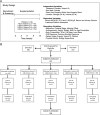A randomized trial of vitamin D₃ supplementation in children: dose-response effects on vitamin D metabolites and calcium absorption
- PMID: 24092833
- PMCID: PMC3849678
- DOI: 10.1210/jc.2013-2728
A randomized trial of vitamin D₃ supplementation in children: dose-response effects on vitamin D metabolites and calcium absorption
Abstract
Context: Changes in serum vitamin D metabolites and calcium absorption with varying doses of oral vitamin D₃ in healthy children are unknown.
Objective: Our objective was to examine the dose-response effects of supplemental vitamin D₃ on serum vitamin D metabolites and calcium absorption in children living at two U.S. latitudes.
Design: Black and white children (n = 323) participated in a multisite (U.S. latitudes 34° N and 40° N), triple-masked trial. Children were randomized to receive oral vitamin D₃ (0, 400, 1000, 2000, and 4000 IU/d) and were sampled over 12 weeks in winter. Serum 25-hydroxyvitamin D (25(OH)D) and 1,25-dihydroxyvitamin D (1,25(OH)₂D) were measured using RIA and intact PTH (iPTH) by immunoradiometric assay. Fractional calcium absorption was determined from an oral stable isotope ⁴⁴Ca (5 mg) in a 150-mg calcium meal. Nonlinear and linear regression models were fit for vitamin D metabolites, iPTH, and calcium absorption.
Results: The mean baseline 25(OH)D value for the entire sample was 70.0 nmol/L. Increases in 25(OH)D depended on dose with 12-week changes ranging from -10 nmol/L for placebo to 76 nmol/L for 4000 IU. Larger 25(OH)D gains were observed for whites vs blacks at the highest dose (P < .01). Gains for 1,25(OH)₂D were not significant (P = .07), and decreases in iPTH were not dose-dependent. There was no dose effect of vitamin D on fractional calcium absorption when adjusted for pill compliance, race, sex, or baseline 25(OH)D.
Conclusion: Large increases in serum 25(OH)D with vitamin D₃ supplementation did not increase calcium absorption in healthy children living at 2 different latitudes. Supplementation with 400 IU/d was sufficient to maintain wintertime 25(OH)D concentrations in healthy black, but not white, children.
Figures




References
Publication types
MeSH terms
Substances
Grants and funding
LinkOut - more resources
Full Text Sources
Other Literature Sources
Medical

